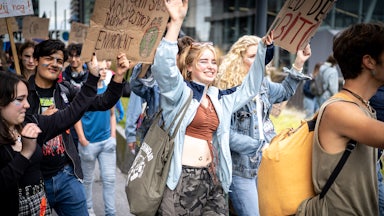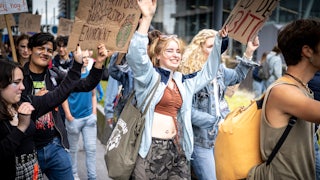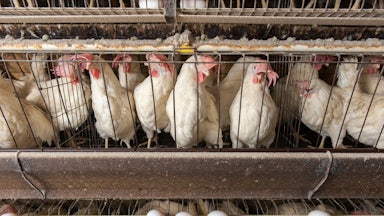Rationing today is seen as a sign that things have gone very wrong. In HBO’s The Last of Us—where humanity has been decimated by a fungal infection that turns people into violent meat sacs—quarantine zone residents swap ration cards for shoelaces and trade them on the black market for drugs. In the real world, meanwhile, produce is being rationed in the United Kingdom amid a whopping 17 percent rise in grocery prices, seen by many as a failure of government planning.
But rationing, when needed, hasn’t always gotten such a bad rap. Sometimes people have even supported it, even after largely declining to reduce their consumption of key goods voluntarily. Exactly one year on from the attack on Pearl Harbor, workers with the Congress of Industrial Unions in New York were urging the U.S. government to ensure that “all essential commodities be rationed at once ‘instead of waiting til scarcities arise or are created,’” The New York Times reported. After the war, British Prime Minister Clement Attlee was reelected by a landslide on his Labour Party’s promise that the country’s ration system would extend into peacetime.
Now a new paper proposes rationing as one policy option to deal with another less-than-ideal situation: the climate crisis. Authors Nathan Wood, Rob Lawlor, and Josie Freear don’t lay out a plan for carbon rationing or even make the case that governments should do such a thing. They argue, rather, that it can be “considered as a policy that would be implemented as part of a broader pluralistic response to climate change.” They see rationing as likely a question of how—not if.
For the world to really tackle climate change, the majority of exploitable coal, oil, and gas will need to stay buried. There are likewise only so many carbon-intensive goods that can continue to be produced and sold absent alternatives that are currently hard to come by, particularly for things like cement and steel. In the future, we’d likely face two options, the authors observe: What can still be burned can either be made available to the highest bidder on the market (“price rationing”) or distributed so as to ensure that everyone can access essential goods.
While seen as painful belt-tightening, rationing has historically had something of an equalizing effect. During World War II, goods like sugar and butter were rationed alongside the gas and rubber used in the production of arms and other wartime necessities. Rationing those items outside of the market via a government program—giving everyone a fair share—meant richer households might consume less while poorer ones could consume more. Amid rationing during the Second World War II, malnutrition in the U.K. went down. In the U.S., meat consumption actually increased by 10 percent.
For climate, the challenge lies in the abstract nature of the scarcity: There is no shortage of carbon but rather of atmospheric space to continue filling with it. “People don’t go to the shop and notice a scarcity of the carbon sink,” Wood told me. “You can keep using it and won’t notice a shortage of that directly because the consequences are temporal and geographic and affect different places differently. The idea that rationing could be as popular as rationing during World War II,” he admits, “is a hard sell.”
Proposals like carbon pricing seek to limit greenhouse gas emissions through so-called market mechanisms, imposing a fee on carbon-intensive goods that better reflects what economists refer to as their “externalities.” Externalities are basically costs—for example, to public health or productivity—that are not reflected in prices. In theory, a fee associated with a carbon price would allow firms and individuals to make more informed choices about what they buy and where they invest. Lower-carbon alternatives will become more attractive options for both as fossil fuels get more expensive.
That creates some obvious distributional problems, though. While economists have tended to imagine carbon pricing as a kind of silver bullet—an elegant, efficient mechanism to reorder the economy—it also assumes every market actor as a cost-optimizing widget. Yet higher prices, which might prod one person into buying a electric vehicle, could also make someone else’s commute prohibitively expensive, particularly if they don’t have cash to drop on a carbon-friendly new car. Making fossil fuels more expensive also does not guarantee that private companies will invest in the energy transition at anywhere near the scale required, particularly when it comes to making renewable power available to poorer households. And even in the absence of a carbon price, policies to restrict the supply of available fossil fuels are very likely to raise prices too. “Those market mechanisms prioritize the wealthy over the poor because it’s the poor who have to change their lifestyles. If you’re wealthy you can afford to adapt,” Wood told me of carbon-pricing schemes. Rationing is one way to make climate policy more fair.
Rationing might come in handy for another, happier aspect of decarbonization. As economist J.W. Mason explains, rationing in the U.S. during World War II was less a response to the war using up essential commodities than to the way war mobilization created a booming job market, boosting demand for those commodities. “Civilian consumption might have been 5 percent higher in 1944 than in 1940; but aggregate civilian wages and salaries were 170 percent higher,” he writes, referencing research by economist Hugh Rockoff. “Prices rose somewhat during the war years; but without price controls and rationing inflation would undoubtedly have been much higher.” Carried out fully, the kind of economy-wide green mobilization that climate-conscious governments have promised may entail similar dynamics, enlisting millions of workers to retrofit buildings and mount transmission lines.
As Wood, Lawler, and Freear note, price controls are an essential complement to rationing so as to “keep key resources affordable for the majority of people, including the poor.” Traditionally rationing systems have meant goods are bought with both ration cards and cash, creating a dual currency system. Price controls help insulate the remaining money economy from the haywire laws of supply and demand. Together, rationing and price controls, the authors explain, “give you an option you simply will not have under other policies: the option to buy goods at a price which is not determined by the market, and which is significantly cheaper than it would be if left to the market.”
The idea of modern price controls seemed outlandish when it was floated by economist Isabella Weber in late 2021. Her Guardian op-ed suggesting that policymakers consider price controls as a tool for dealing with inflation sparked a freak-out among some of the country’s highest-profile economists. New York Times columnist Paul Krugman called the idea “truly stupid,” before deleting the tweet and apologizing. Not long after the column, Russia invaded Ukraine and Europe found itself staring down the barrel of an energy crisis, with key fuel sources threatened by sanctions and sabotage. Suddenly, price controls were back on the table and on the lips of top policymakers in the European Union. Krugman ate crow.
But if today’s inflation makes an easy populist case for price controls—limiting corporations’ ability to charge exorbitant sums—rationing is murkier territory for those that might otherwise embrace big government interventions. As a corrective to earlier eras when environmentalists fixated on lifestyle choices, left-leaning climate hawks now tend to de-emphasize questions of consumption, highlighting corporations’ stranglehold on politics, the grossly outsize carbon footprints of the ultrawealthy, and the need for structural changes. Core to varied proposals for a Green New Deal is an investment-led approach to decarbonization wherein an economy-wide mobilization for a greener future yields a fairer and more abundant one too; millions of jobs will be created to provide large-scale, low-carbon infrastructure (trains, housing, energy, etc.) as desirable public goods, not rarefied commodities that it’s up to individuals to purchase.
The Inflation Reduction Act offers a kind of funhouse-mirror version of that theory: State-furnished subsidies and tax breaks will make it cheaper for corporations to produce certain goods and for consumers to buy them, allowing the U.S. to build a twenty-first-century manufacturing base in the process. Over time, people and companies will buy and build (respectively) more low-carbon things. The fossil fuel economy will erode on the shores of a market properly incentivized to go green.
“Ecomodernist” thinkers, clustered at institutions like the Breakthrough Institute, look to elide the question of consumption by pointing to still far-off technologies that promise to make bourgeois abundance accessible to the masses—a “politics of more,” as geographer Matt Huber has put it. Asteroid mining or nuclear fusion, for instance—where there have been exciting recent breakthroughs—can allow society to transcend its material limits and offer infinity pools and private jets for all.* But even if we accept the premise that these technologies can be scaled up in time to rapidly replace their fossil fueled alternatives (let’s hope so!), that leaves a major question on the table: Is bourgeois consumption good?
In lieu of today’s hyper-individualized forms of energy consumption, Wood, noted, “you can have a city with inclusive mass transit and good building codes that build places that are cheap for people to live in and well insulated. The idea that current energy consumption is the best way to meet our wellbeing is absurd.” But likewise, he added, “It’s a misconception that the goal to reduce energy consumption and resource use requires us to lower our standard of living.” It might just mean living differently.
It’s odd, in that sense, that climate advocates who call for transforming what powers the world—from the Biden administration to the ecomodernists—also imagine tastes for big cars and meat-heavy diets as a fixed part of human brain chemistry. Wood, Lawlor, and Freear’s paper is concerned with a different question: how to equitably distribute goods that should be scarce. But it raises a basic point that climate advocates of various political stripes have been eager to avoid: Consumption does need to change to deal with the climate crisis. And there are not one-to-one substitutes readily available for every facet of carbon-intensive life as we know it. Whether the shift ahead is administered by the invisible hand or an egalitarian state program will determine what life looks like on the other side of the energy transition—whether it’s fair, and whether it happens at all.
* This piece has been updated to reflect that the technology that has recently experienced a breakthrough is nuclear fusion, not fission.










